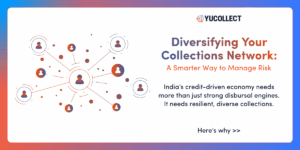
India’s collections are moving from manual follow-ups to software-driven, borrower-friendly operations. AI, cloud platforms, omnichannel messaging, and built-in compliance are changing how lenders and agencies work. The goal is simple: better recoveries with less risk, more trust, and fewer complaints.
Why digital is accelerating
Stronger market pull. More lenders and agencies are adopting collection software every year. The shift is steady and long-term.
More unsecured credit. As personal loans, credit cards, and BNPL grow, recovery needs to be disciplined and data-driven.
Tighter compliance. Consent, call timing, language, and transparency are now non-negotiable. Digital systems make these rules easier to follow.
Proven results. Large lenders that moved to platforms report faster collections and lower operating costs. The lesson: process + tech works.
What “good” digital collections looks like
- Consent-first engagement. Every message and call is consented, time-stamped, and easy to audit.
- Predictive prioritisation. The right account is contacted at the right time with the right offer.
- Omnichannel journeys. WhatsApp, SMS, email, IVR, and a self-serve portal—joined up, not scattered.
- Agent assist + quality controls. Scripts, nudges, and automatic QA keep each interaction compliant.
- Real-time visibility. Lenders and agencies see attempts, outcomes, and complaints as they happen.
Key trends to watch in the years to come
1) AI and machine learning everywhere.
AI improves segmentation, contact timing, message tone, and negotiation flows. It flags risky phrases in calls and speeds up QA. Humans stay in the loop for fairness and judgment.
2) Cloud-native collection stacks.
API-first systems connect faster to core banking, LOS/LMS, UPI Autopay, wallets, and accounting. Role-based access and audit logs are built in.
3) Predictive and personal strategies.
Scores estimate “promise-to-pay kept” (PTP-kept). Plans adjust to income patterns. Messages and channels are A/B-tested to find what works best.
4) Omnichannel with payment inside.
WhatsApp/SMS links, email pay buttons, IVR callbacks, and a simple portal reduce steps and raise first-contact resolution.
5) Regulation and compliance automation.
Template approval, contact-window checks, attempt caps, consent logs, language localisation, and red-flag alerts make “compliance by design” real—even at scale.
Trends and partnerships powering the shift
- UPI and BNPL integrations enable low-friction repayments right inside the message flow.
- Open commerce and distribution rails add standard, low-cost touchpoints across India.
- Fintech partnerships help lenders and agencies build end-to-end, digital-first recovery setups.
The ethical bias needed
India’s playbook is changing from force-driven to trust-driven. Flexible plans that respect income cycles, clear and multilingual disclosures, and respectful scripts reduce disputes. When needed, hand-off to a human who can listen and solve. This approach increases cooperation and strengthens confidence among lenders (allocators), agencies, and borrowers.
Predictions for 2025–2030
- Agentic AI in production. Supervised, auditable virtual agents will converse, negotiate, and schedule under human oversight.
- Real-time risk monitoring. Continuous scoring will guide proactive outreach instead of reactive chasing.
- Tamper-proof evidence trails. Blockchain-backed logs may secure disputes and audits end-to-end.
- Responsible AI as a must-have. Model governance, explainability, and bias checks will become standard vendor selection criteria.
A 90-day playbook to go digital
Weeks 1–2: Foundations
- Map borrower journeys: consent, languages, contact windows, escalation.
- Cleanse portfolio data. Standardise dispositions and outcomes.
Weeks 3–6: Systems and pilots
- Implement a cloud collection stack with approved, consented templates.
- Activate UPI Autopay links, a self-serve portal, and WhatsApp templates.
- Pilot on 2–3 buckets with control vs. treatment groups to measure lift.
Weeks 7–10: AI and quality
- Roll out risk and propensity models for prioritisation.
- Start call-listening with red-flag phrase detection.
- Coach agents weekly using insights from data.
Weeks 11–13: Scale and governance
- Expand to the full portfolio.
- Publish live dashboards for lenders and leadership.
- Formalise complaint SLAs, run root-cause reviews, and schedule quarterly independent audits.
Metrics that matter
- PTP-kept rate by bucket and channel.
- Self-serve adoption and first-contact resolution.
- Contact-window breaches and attempt-cap adherence.
- Complaint rate and time to closure.
- Evidence completeness (consents, call notes, templates).
How unified infrastructure helps
- Smarter discovery and allocation. Match the right accounts to the right agencies using data, not guesswork.
- Checklist by default. Time windows, consent checks, and attempt caps applied to every outreach automatically.
- Strong evidence trails. Immutable logs for every contact—ready for governance and audits.
- Live conduct monitoring. Track agent behaviour, complaints, and outcomes in real time; intervene early.
- Personalisation at scale. AI-assisted segmentation and borrower-friendly plans improve voluntary repayment.
Final word
India’s next phase of collections will be smarter, fairer, and more transparent. AI, cloud platforms, predictive analytics, and omnichannel journeys—anchored in compliance—will set leaders apart. Teams that invest now will earn higher voluntary repayments, reduce legal and reputational risk, and build stronger, longer-term partnerships between lenders and agencies. Digital is not just a new toolset; it is a better way to run collections—clear, respectful, and effective.









